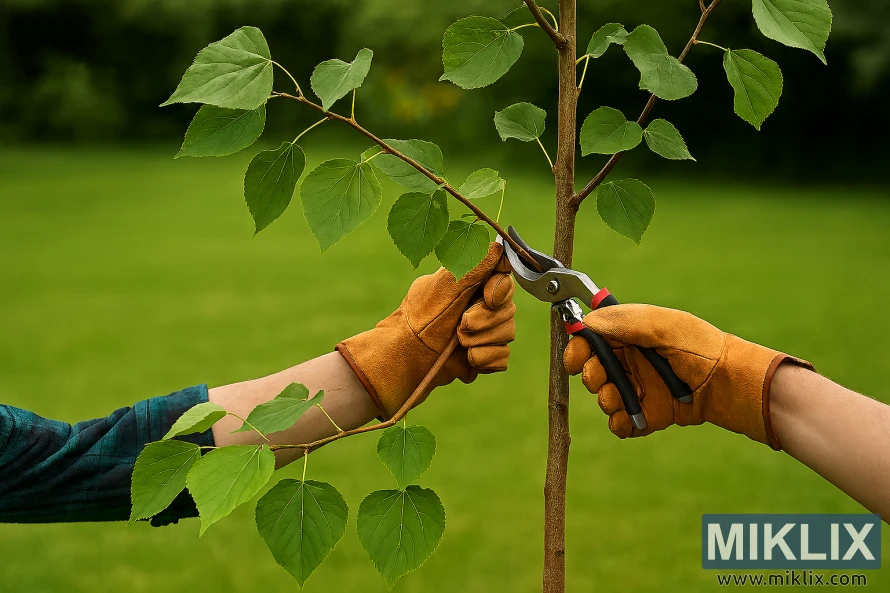Image: Pruning a Young Linden Tree for Structural Integrity
Published: October 23, 2025 at 9:36:05 PM UTC
Explore the correct pruning method for young Linden trees to promote strong structure and healthy growth, featuring clean cuts and canopy shaping.
In a lush garden setting under soft daylight, a young Linden tree (Tilia) is being pruned with precision and care—an essential practice for shaping strong, structurally sound specimens. The tree stands upright with a slender, light brown trunk that rises vertically from the lawn. Its bark is slightly rough and fibrous, and the trunk supports a modest canopy of vibrant green, heart-shaped leaves with serrated edges and prominent veins. These leaves are arranged alternately along thin branches, some of which extend outward while others curve inward or cross over neighboring limbs.
The focal point of the image is a pair of gloved hands performing a pruning cut. The gardener wears tan leather gloves with visible creases and stitching, suggesting frequent use. The left hand grips a slender lateral branch, steadying it for removal, while the right hand operates a pair of sharp, silver bypass pruning shears with red handles and black grips. The shears are positioned just outside the branch collar—where the branch meets the trunk—ensuring a clean, angled cut that promotes proper healing and minimizes disease risk.
The pruning target is a thin, inward-growing branch that could compromise the tree’s central leader and overall structure if left unchecked. The gardener’s technique reflects best practices: removing competing branches, maintaining a single dominant leader, and preserving evenly spaced lateral limbs to encourage balanced growth. The tree’s canopy is open and airy, allowing light and air to penetrate, which supports healthy foliage and reduces fungal pressure.
The background features a well-maintained lawn with dense, upright blades of grass that stretch into the distance. Beyond the lawn, a line of mature trees and flowering shrubs forms a natural border. Some of these trees appear to be older Linden specimens, their broader canopies and symmetrical branching patterns hinting at years of careful pruning. The shrubs add seasonal color and texture, with hints of yellow and purple blooms visible in the blurred distance.
The lighting is soft and diffuse, likely filtered through light cloud cover, which enhances the image’s realism and depth. Shadows are gentle, and the color palette is dominated by rich greens and earthy browns, punctuated by the metallic sheen of the pruning shears and the warm tones of the gardener’s gloves.
This image not only captures the act of pruning but conveys the principles of formative tree care: selective cuts, structural shaping, and attention to long-term integrity. It serves as a visual guide for gardeners aiming to cultivate resilient Linden trees with strong architecture and aesthetic appeal.
The image is related to: The Best Linden Tree Varieties to Plant in Your Garden

